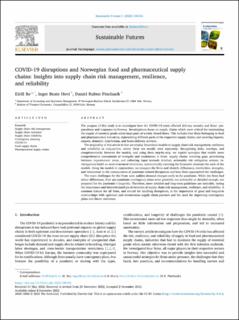| dc.contributor.author | Bø, Eirill | |
| dc.contributor.author | Hovi, Inger Beate | |
| dc.contributor.author | Pinchasik, Daniel Ruben | |
| dc.coverage.spatial | Norway, Oslo | en_US |
| dc.date.accessioned | 2023-06-14T14:16:48Z | |
| dc.date.available | 2023-06-14T14:16:48Z | |
| dc.date.created | 2022-12-13T16:41:10Z | |
| dc.date.issued | 2022-12-08 | |
| dc.identifier.citation | Sustainable Futures. 2022, 5 (December 2023), 1-11. | en_US |
| dc.identifier.issn | 2666-1888 | |
| dc.identifier.uri | https://hdl.handle.net/11250/3071381 | |
| dc.description | Published by Elsevier Ltd. This is an open access article under the CC BY license (http://creativecommons.org/licenses/by/4.0/). | en_US |
| dc.description.abstract | The purpose of this study is to investigate how the COVID-19 crisis affected delivery security and firms’ preparedness and responses in Norway. Investigations focus on supply chains which were critical for maintaining the supply of essential goods when large parts of society closed down. This includes four firms belonging to food and pharmaceutical industries, representing different parts of the respective supply chains, and covering imports, exports, domestic distribution, and home-delivery services. The originality of this article is that we employ theoretical models on supply chain risk management, resilience and reliability in conjunction, where these are usually used separately. Recognizing links, overlaps, and complementarity between the models, and using them step-by-step, we exploit synergies that enable more comprehensive assessments of strengths and weaknesses in firms’ supply chains, covering gaps, prioritizing between improvement areas, and collecting input towards detailed, actionable risk mitigation actions. Investigations build on semi-structured interviews, systematically covering the formative elements for each of the models. Using the models in conjunction, we compare the firms and identify differences, similarities, strengths, and weaknesses in the consequences of pandemic-related disruptions and how firms approached the challenges. The main challenges for the firms were sudden demand changes early in the pandemic. While the firms had minor differences, their pre-pandemic contingency plans were generally not actionable or detailed enough, nor prepared for the pandemic's longevity. Therefore, more detailed and long-term guidelines are desirable, noting the importance and interrelationships of elements of supply chain risk management, resilience, and reliability. A common feature for all firms, and crucial for handling disruptions, is the importance of good and long-term relationships with upstream and downstream supply chain partners and the need for improving contingency plans and future resilience. | en_US |
| dc.description.abstract | COVID-19 disruptions and Norwegian food and pharmaceutical supply chains: Insights into supply chain risk management, resilience, and reliability | en_US |
| dc.language.iso | eng | en_US |
| dc.publisher | Elsevier | en_US |
| dc.rights | Navngivelse 4.0 Internasjonal | * |
| dc.rights.uri | http://creativecommons.org/licenses/by/4.0/deed.no | * |
| dc.subject | Supply chain risk management | en_US |
| dc.subject | Supply chain resilience | en_US |
| dc.subject | Contingency planning | en_US |
| dc.subject | COVID-19 | en_US |
| dc.subject | Food supply chains | en_US |
| dc.subject | Pharmaceutical supply chains | en_US |
| dc.title | COVID-19 disruptions and Norwegian food and pharmaceutical supply chains: Insights into supply chain risk management, resilience, and reliability | en_US |
| dc.title.alternative | COVID-19 disruptions and Norwegian food and pharmaceutical supply chains: Insights into supply chain risk management, resilience, and reliability | en_US |
| dc.type | Journal article | en_US |
| dc.type | Peer reviewed | en_US |
| dc.rights.holder | © 2022 The Author(s). | en_US |
| dc.source.articlenumber | 100102 | en_US |
| dc.description.version | publishedVersion | en_US |
| cristin.ispublished | true | |
| cristin.fulltext | original | |
| cristin.qualitycode | 1 | |
| dc.identifier.doi | 10.1016/j.sftr.2022.100102 | |
| dc.identifier.cristin | 2092726 | |
| dc.source.journal | Sustainable Futures | en_US |
| dc.source.volume | 5 | en_US |
| dc.source.issue | December 2023 | en_US |
| dc.source.pagenumber | 1-11 | en_US |

